Diana Gerritsma leads marketing and communications at Het Vogelnest, a community centre based in the Vogelbuurt neighbourhood of Dordrecht. In this interview, she dives into the value of citizen engagement and offers guidance on working with communities for greening and biodiversity initiatives.
Tell us a bit about yourself and Het Vogelnest?
My name is Diana Gerritsma, and I'm responsible for marketing and communications at Vogelnest. I'm also involved in various social initiatives. Additionally, I work as a social worker at Vogelnest and will do the same in Staart Oost.
Vogelnest is a community centre located in the heart of Vogelbuurt, a neighbourhood named the “bird’s neighbourhood” where each street is named after a different bird. Vogelnest, or the “bird’s nest” was founded seven years ago to address a multitude of issues in the area, with the goal of improving the neighbourhood. It's not just a coffee bar; it's a social coffee bar. We often say, "Strong coffee for a strong neighbourhood." Visitors and staff at Vogelnest can enjoy a cup of coffee, engage in small talk, and seek help, both from their neighbours and our team. Many of my colleagues have strong backgrounds in social work, and we've built an extensive network in Dordrecht, connecting people to assistance in various areas, such as finances, health, housing, and education. Sometimes, it's as simple as a friendly conversation to brighten someone's day.
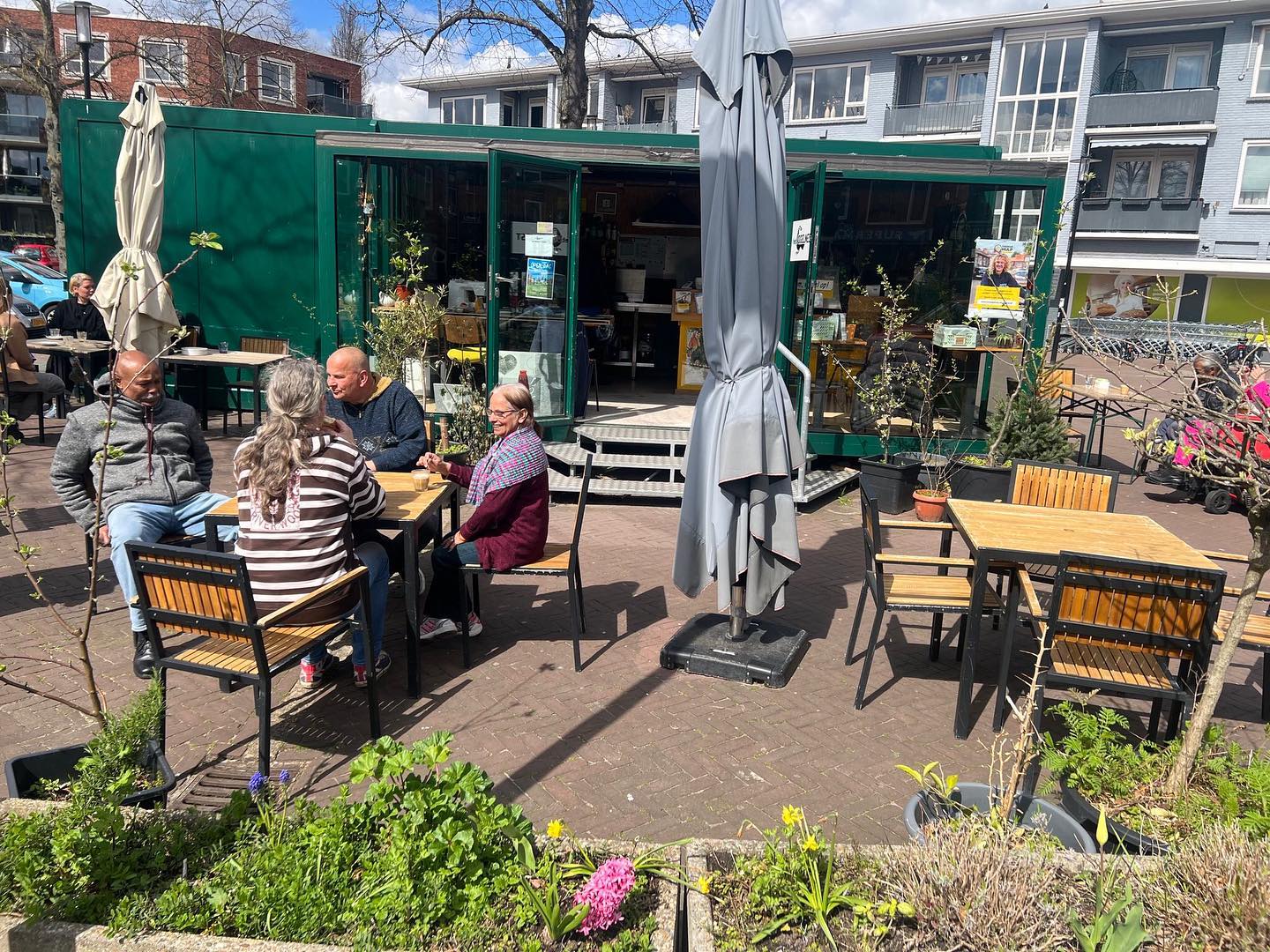
A recent snapshot of the community enjoying time together at Vogelnest
Vogelnest operates seven days a week, with one of my colleagues present each day, ensuring a continuous social presence. However, it heavily relies on volunteers, which is fundamental to its success. Vogelnest serves as a central hub for various neighbourhood projects, including "Boom zoekt grond," which we initiated last year, and other initiatives aimed at improving the neighbourhood. It's not just about adults; Vogelnest also hosts events for children, like block parties with delicious food and entertainment. Additionally, we create opportunities for open dialogues on important topics within the community. Coffee is a universal language, and it brings people together in a beautifully organic way.
Vogelnest is a beacon of growth in Vogelbuurt, and it's much more than just a coffee bar; it's a lifeline for the community, fostering connections and support that are vital for neighbourhood well-being.
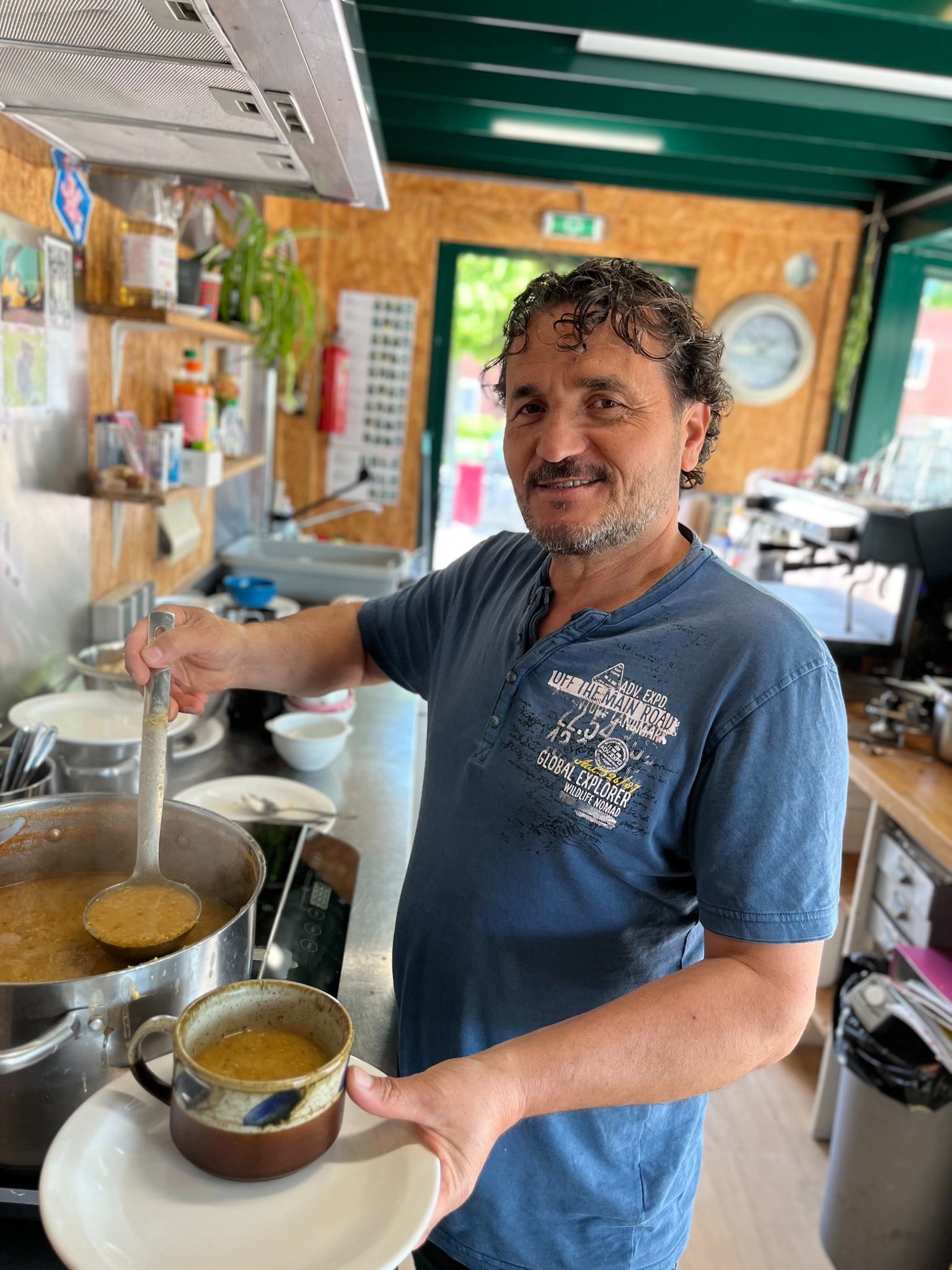
Soup Day at Vogelnest: each Thursday, a volunteer makes and serves free soup to the community
Why is community engagement such an important part of urban biodiversity projects like Biodiverse Cities? Why is it so important to create shared ownership and responsibility over public spaces?
Community engagement is crucial for projects like Biodiverse Cities for several compelling reasons. It might sound a bit unusual, but I like to think of it as adding "private green" to "public green," thereby extending the project's reach. In Vogelbuurt, we faced a challenge where there wasn't much room for increasing green spaces within the public realm. That's when we came up with the idea of involving the community and incorporating private spaces into the equation. This practical approach allowed us to expand the project's footprint and impact.
However, community engagement goes beyond the practical aspects. It also plays a pivotal role in instilling a sense of responsibility for biodiversity and enhancing public awareness and commitment to both public and private green spaces. Yet, the most significant aspect, in my opinion, is the connection to one's own living environment. When people genuinely enjoy their surroundings, they naturally feel a deeper sense of responsibility towards it. This is exactly what we've observed in Vogelbuurt.
Shared ownership and responsibility are critical not only for the immediate success of the project but also for its long-term sustainability. By fostering a sense of shared ownership, we ensure that the community continues to be invested in the project, and this enduring commitment is what allows biodiversity to thrive in the years to come. It's all about nurturing a collective sense of stewardship over our environment, and that's where the true potential of Biodiverse Cities lies.
Why are you focusing on Staart Oost as a pilot?
Focusing on Staart Oost is a strategic choice as this district holds a pivotal location with immense potential for increasing biodiversity in the wider region. It's situated between two significant rivers, Wantij and Beneden Merwede, and it shares its borders with the expansive tidal area known as the Biesbosch, which is a national park here in the Netherlands of great ecological importance.
The significance of Staart Oost lies in its position as the nexus connecting these three vital natural environments. The Biesbosch, Wantij, and Beneden Merwede host diverse species of flora and fauna. By improving Staart Oost as a connecting area between these natural habitats, we can facilitate the expansion of these species' habitats. This expansion, in turn, benefits both the local flora and fauna, fostering a more robust ecosystem.
Currently, the connectivity between these areas isn't as efficient as it could be. Staart Oost's potential as a corridor between these natural spaces is underutilised. Therefore, our focus on Staart Oost is driven by the opportunity to enhance this connection, ultimately benefiting the broader biodiversity in the region. It's a critical area for our pilot project because it represents the cornerstone of a healthier and more interconnected ecosystem for the benefit of all.
What challenges do you face in this pilot? What solutions are you using or exploring?
The pilot in Staart Oost does come with its share of challenges, some of which draw from our experiences in Vogelbuurt. While we anticipate encountering similar challenges, there may also be new ones to contend with. Here are some of the key hurdles we're addressing:
1. Lack of Resident Involvement: One challenge we foresee is the limited involvement of residents in the initial stages of the project. This is a common issue we encountered in Vogelbuurt as well.
Solution: To overcome this challenge, we've learned the importance of maintaining an open and ongoing conversation with the community. Continuous engagement and communication help build awareness and knowledge about the project's goals and benefits.
2. Resident Objections and Scepticism: Residents may raise objections and express scepticism about the importance of biodiversity and climate adaptation. This can be a barrier to project progress.
Solution: Addressing objections and scepticism requires patience and a willingness to listen. It's crucial to understand residents' concerns and explore how project objectives align with their needs and interests. In Vogelbuurt, for example, we faced objections when introducing a tiny forest due to concerns about insects and maintenance. However, once we explained how the project could alleviate issues like shed flooding during extreme rains, residents became more receptive.
3. Building Awareness: Often, residents may not fully comprehend why biodiversity and climate adaptation matter to them personally.
Solution: We emphasise the importance of explaining the practical implications. In our experience, this has been a critical step in gaining community support. By illustrating how the project benefits residents in terms of addressing issues like extreme weather, flooding, and drought, we can bridge the gap between the project's goals and the residents' everyday lives.
4. Harnessing Resident Cooperation: Finding residents who are willing to cooperate and become project ambassadors can be challenging.
Solution: Identifying and nurturing residents who are enthusiastic about the project is vital. These individuals can serve as community ambassadors for both small and large initiatives, creating a sense of unity within the neighbourhood.
In essence, successful community engagement lies in continuous dialogue, addressing objections with patience and clarity, and highlighting the practical benefits of biodiversity and climate adaptation. It's not just about creating a project; it's about fostering a sense of shared responsibility and collaboration within the community, ensuring long-term project viability and success.
What communication and engagement modes do you use to meet residents?
Our approach to communication and engagement with residents in Staart Oost is multifaceted, drawing from our experiences in Vogelbuurt and tailored to the unique needs of the community:
1. Community Centre: We're establishing a community centre in Staart Oost, which plays a pivotal role in engaging with residents. This centre serves as a hub for various activities and meetings. Importantly, it addresses a specific need voiced by the residents themselves, as they expressed a desire for a place to gather, interact, and support one another.
2. Direct Engagement: We believe in the power of one-on-one conversations. Going door to door and speaking individually with residents has proven to be a highly successful strategy in Vogelbuurt. This personal touch allows us to understand their concerns, answer questions, and build a stronger connection with the community.
3. Intervision Days: We plan to organise intervision days, where we assemble a group of people, including colleagues from our larger organisation, to visit residents collectively. These days are not only about conversation but also action. For instance, we might engage in practical activities like digging holes and placing buckets with water or small dish tops to create habitats for amphibians. This hands-on approach reinforces our commitment to the project and helps residents see tangible results.
4. Online Communication: We recognise the importance of digital communication in the modern world. We'll use newsletters, websites, and social media platforms like Facebook to keep residents informed and engaged.
5. Local Media: Local media outlets provide an essential platform for reaching a wider audience. Sharing project updates and success stories through these channels helps spread awareness and garner support.
Our approach is comprehensive, combining physical presence, digital outreach, and community-driven initiatives. We believe that this multifaceted engagement strategy will foster a strong sense of community involvement and ownership in the Staart Oost biodiversity project, ensuring its success and sustainability.
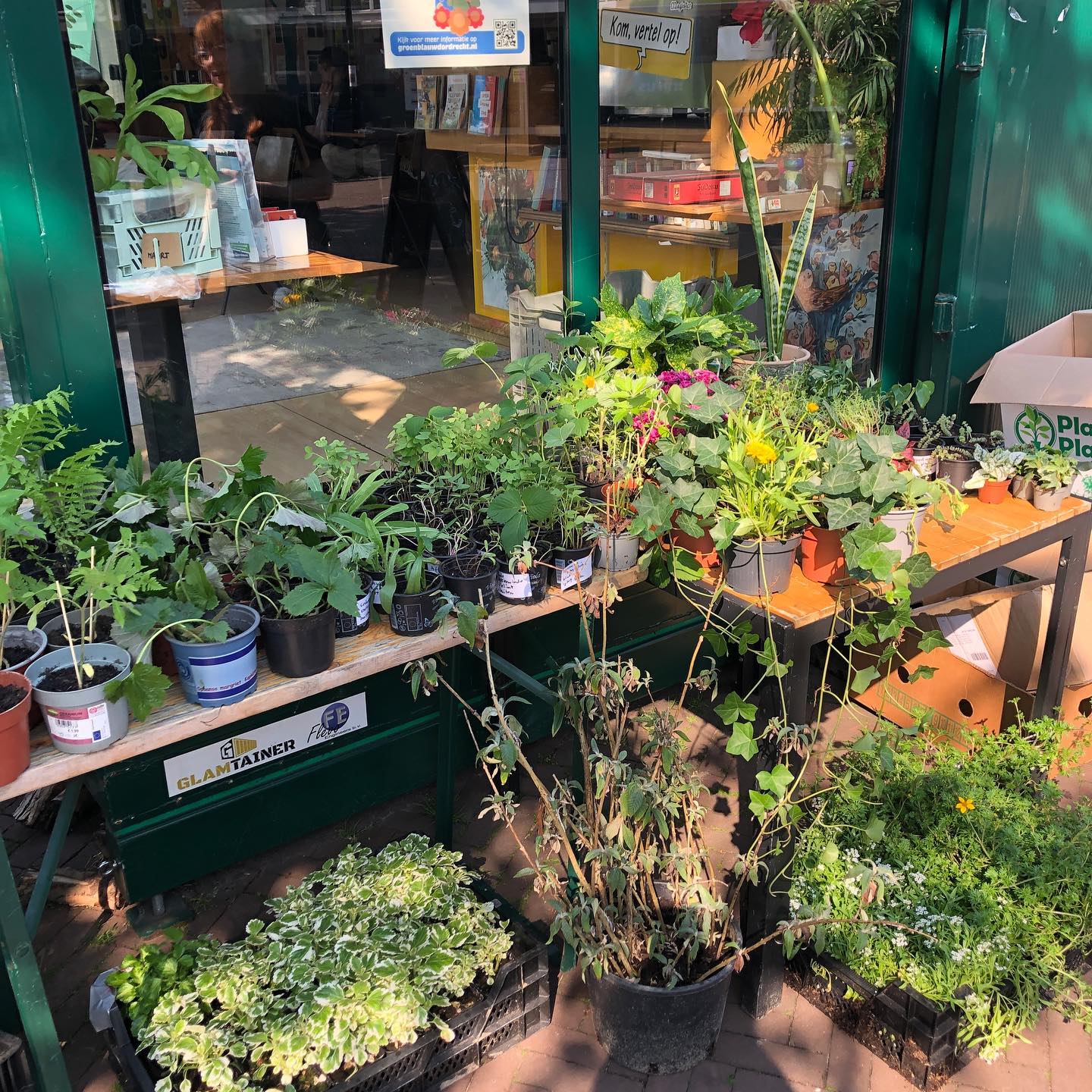
Plants outside of Vogelnest on one of their recurring plant-trade days
How do you build relationships with residents to establish a reliable community group?
Building strong relationships with residents and establishing a reliable community group is at the heart of our mission, and we have a multi-pronged strategy to achieve this. The community centre plays a pivotal role in this endeavour. It provides an opportunity not only to engage with residents but also to deepen our connection with the community. Through this centre, we aim to bring our mission closer to the people, making it more personal. The fact that our team members are residents themselves creates an emotional bond, as we all share the same concerns and love for Dordrecht. It's about forging a genuine connection with the community.
Consistent engagement is essential to our approach. Even before the physical community centre has been established, we've been going to the neighbourhoods every week for two hours. Here, we provide coffee, tea, and lemonade for kids, along with activities like ball games. This initiative has allowed us to make direct contact with residents, fostering relationships and gaining their trust. It's gratifying to see the enthusiasm and willingness to support our green initiatives grow with each interaction.
Engaging children is a vital part of our strategy. By organising activities for children, we not only reach out to parents but also educate the younger generation about their environment and the challenges it faces. We've witnessed firsthand in Vogelnest how involving children deepens the connection within the community.
The physical community centre is still in the administrative process, dealing with permits and other logistics. However, our early efforts have yielded promising results. Residents are showing a keen interest in our mission, and we anticipate even greater success once the community centre is established. The key to success lies in these personal connections and the genuine sense of community that is being nurtured through our ongoing efforts. We are optimistic about the future and look forward to achieving our goals together with the residents of Staart Oost.
What are the biggest deterrents for residents who want greener environments but aren’t participating?
In our summer 2021 survey with residents, it was found that while the majority recognized the benefits of greenery and expressed an interest in greening their gardens, only about 20% of households were initially expected to participate in the "Boom zoekt grond" project and follow through with garden greening. However, it's important to note that this percentage has increased over time. In the last phase of the project, nearly 900 plants and approximately 39 trees were planted, which exceeded initial expectations.
Several key deterrents have been identified for residents who initially expressed a desire for greener environments but did not participate. Many residents face time constraints due to various life circumstances. In neighbourhoods like Vogelbuurt and Staart Oost, there are single parents, families experiencing financial difficulties, individuals working multiple jobs, and elderly residents who may not be physically able to engage in greening activities. These time constraints can hinder their ability to participate in such projects.
Another significant deterrent is residents' suspicion of the government and feeling unheard. Some residents want to actively contribute to creating a greener environment but don't feel their opinions and ideas are taken into account. There is a perception that the government may pursue agendas that are disconnected from what residents truly want or need. When residents perceive a disconnect between their desires and government actions, it can lead to disengagement from such projects.
Engaging an intermediary like Vogelnest can help close the gap between citizens and governments. When reaching out to the community, we can emphasise that we are not government representatives and aim to establish trust with the community by making this clear. Vogelnest serves as a bridge between residents and the government, facilitating communication and sometimes assisting residents in navigating bureaucratic processes.
While Vogelnest can provide support and connections, we are always honest about which issues can be resolved, and which cannot. Some government processes may remain unchanged. However, the message we convey to residents is that we are on their side and understand the challenges they face. This understanding, coupled with our broader network and resources, allows us to assist residents in solving problems they may not have been able to address independently. This approach fosters trust and can lead to a renewed sense of collaboration between residents and the government when residents see that their concerns are being heard and acted upon.
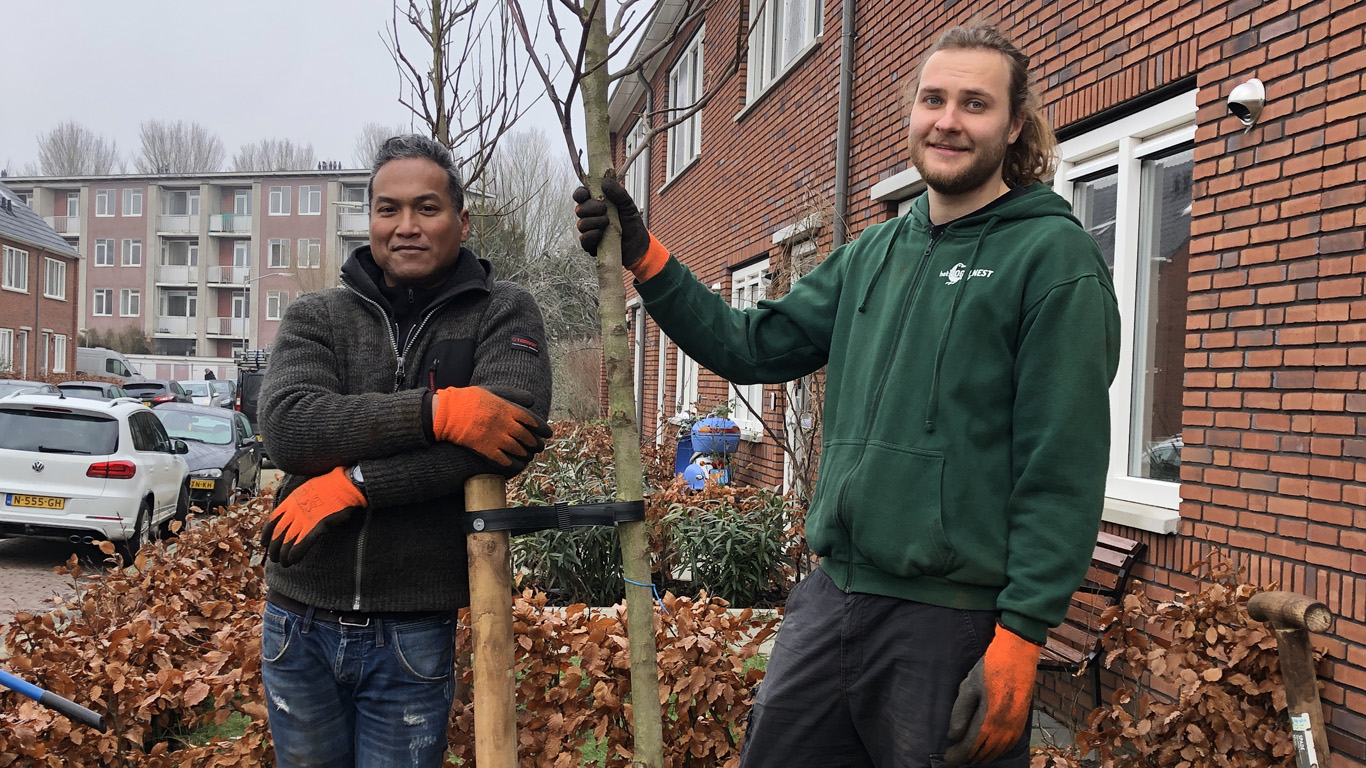
Vogelnest colleagues Patrick Asmawidjaja (left) and Tom Harbers (right) planting a tree for the Boom Zoekt Grond project
For the residents who are not interested or are actively against greening - what are their concerns? What would be the best way to address their concerns?
Residents who are not interested in or actively against greening their surroundings express a diverse range of concerns. These concerns encompass a broad spectrum, including a lack of trust in government initiatives, time constraints due to busy lives, fears related to insects and wildlife that green spaces might attract, concerns about ongoing maintenance responsibilities, and worries about the potential for green areas to attract litter or unwanted visitors, thereby impacting safety.
Addressing these concerns comprehensively can be challenging, but our approach is rooted in open and honest engagement with residents. We listen attentively to their worries and strive to develop plans that take their needs and preferences into account. Our overarching goal is to ensure the success of our projects by incorporating as many viewpoints as possible, even if we can't completely eliminate every concern.
Transparency throughout this is key. We communicate candidly with residents about potential issues, such as the presence of insects or the need for ongoing maintenance. This approach is crucial in building trust and establishing a foundation for collaboration.
In addition, we emphasise the practical benefits of biodiversity and green initiatives. We highlight how these efforts contribute to climate change adaptation and mitigation, underscoring their significance in preventing issues like flooding during heavy rains.
Our broader message revolves around community-building. We invest time in fostering a sense of community responsibility, stressing that greening initiatives are not solely imposed by the government but are a collective endeavour that can yield benefits for everyone involved. While we acknowledge that not all concerns can be completely resolved, our aim is to make residents perceive greening initiatives as a positive addition to their neighbourhood, with any remaining concerns being outweighed by the overall advantages of creating a greener and more sustainable environment through collaborative effort and mutual understanding. The most important thing to remember is that though you can’t solve everything, you can take your time together and build solutions together.
We know that we cannot please everyone and agree with everyone when making a decision - so how do we decide when there is not a consensus? How do we make good decisions?
When making decisions, it's important to acknowledge that achieving consensus or satisfying every stakeholder can be a challenging, if not unattainable, goal. When faced with situations where unanimity is elusive, it's imperative to take a pragmatic approach focused on overarching objectives and priorities.
Rather than becoming bogged down in attempts to appease those who may resist or deny certain initiatives, the focus should be on the broader success and the growth of awareness within the community. This approach means nurturing the positive aspects, fostering unity and collective action, and cultivating a shared dedication to what's beneficial for the community and the environment.
In practical terms, the decision-making process involves several key elements:
Inclusivity: Ensuring that a wide spectrum of voices and perspectives is considered during the decision-making process. This aids in gaining a comprehensive understanding of the issues at hand.
Open Dialogue: Encouraging transparent and constructive dialogue among stakeholders. This enables the exchange of ideas and concerns, contributing to a more informed decision-making process.
Focus on Goals: Keeping the primary objectives and long-term goals at the forefront. Decision-making should be guided by what serves the community and the environment best, rather than catering to specific individuals or groups.
Consensus Building: Striving to build consensus whenever feasible, seeking common ground among stakeholders. This may involve making compromises or adjustments to accommodate different viewpoints.
Empowerment: Empowering individuals and the community to take ownership of the decisions and their outcomes. Active participation and collaboration should be encouraged.
Incremental Progress: Recognising that meaningful change often unfolds gradually. Instead of expecting immediate consensus, it's important to concentrate on making incremental progress and nurturing the growth of support and awareness over time.
Don't Give in to Cynicism: Maintaining a hopeful and positive outlook is essential when confronted with resistance or polarisation. It's vital not to succumb to cynicism or frustration. Instead, maintain the belief that, as awareness and commitment to positive change expand, the group of deniers or resistant individuals may diminish.
Ultimately, the decision-making process should prioritise the greater good and the welfare of the community and the environment. While differences of opinion and resistance will always exist, the key is to persist, retain a sense of purpose, and continue investing in people, beliefs, and actions that contribute to positive change.
What are your expectations for Biodiverse Cities - both in the short term, by project end, and after project close?
My expectations for Biodiverse Cities are filled with hope and optimism. While I cannot predict with certainty what will transpire, I envision several outcomes:
In the short term, by the project's conclusion, I hope to see substantial progress in community engagement and awareness-building. I expect that we will have initiated changes that will endure over time. These changes should not solely rely on ongoing human intervention but become self-sustaining.
Specifically, I look forward to watching the Staart grow into a robust and natural connection between the various surrounding areas I mentioned earlier. Ideally, it should function independently, akin to a well-oiled system. In essence, our role should evolve from being active participants to facilitators and observers, as the ecosystem we help create continues to thrive.
Looking further ahead, perhaps five to ten years down the road, my aspiration is that the systems and initiatives set in motion during Biodiverse Cities will become self-perpetuating. The project should leave a lasting legacy, where the community and nature coexist harmoniously, and the principles of biodiversity and sustainability are deeply ingrained in the fabric of the neighbourhood. In this envisioned future, our direct involvement may diminish as the community and the ecosystem take on a life of their own, perpetuating the positive changes we initiated.
Ultimately, my expectation and hope are for a sustainable, self-sufficient ecosystem that continues to flourish long after the project's formal conclusion.
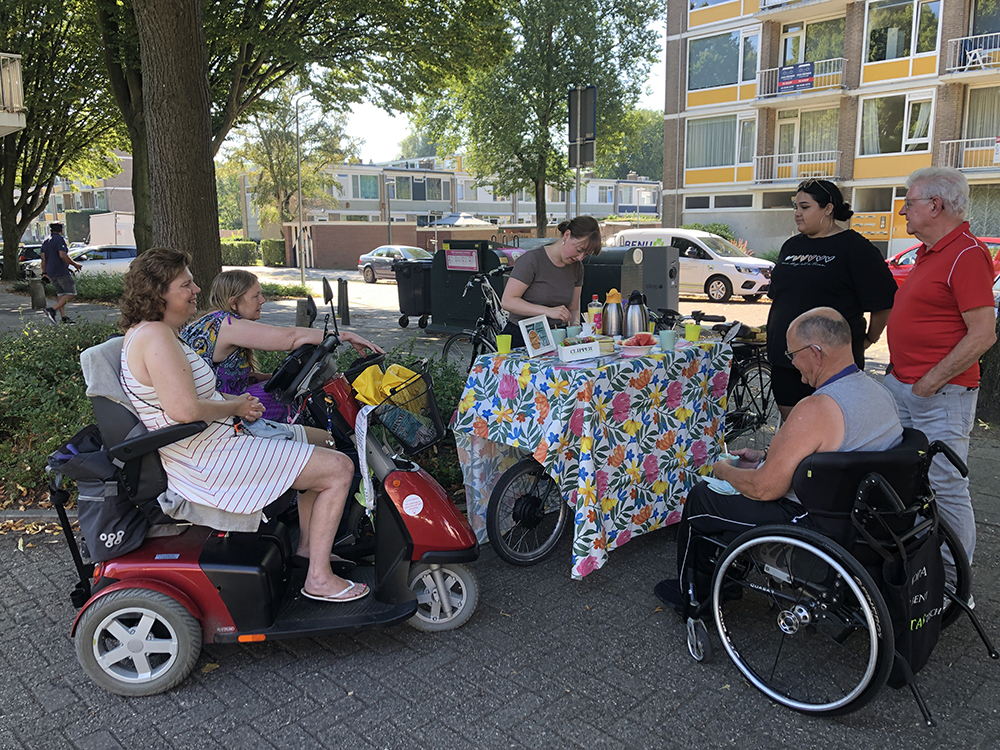
The Staart community gathers around Vogelnest's mobile coffee stand, which makes weekly appearances while awaiting the new neighbourhood centre
With the impacts of the climate crisis becoming more present for the average citizen each year (through floods, droughts, wildfires, heatwaves, and other extreme weather events for example) how is citizen engagement evolving?
Certainly, as the effects of the climate crisis become more evident in the lives of everyday citizens, citizen engagement is evolving in several key ways.
First, there's a noticeable increase in awareness and a growing willingness to take action. People are witnessing climate-related events firsthand, such as floods, wildfires, and extreme weather, which is prompting them to recognise the urgency of the situation and their role in addressing it.
At the same time, there's a growing sense of collective responsibility. Individuals understand that climate change affects everyone, regardless of their background or location. This collective mindset is motivating people to contribute to solutions, whether through personal lifestyle changes or community initiatives.
However, this growing awareness is accompanied by polarisation and climate denial. Extreme viewpoints on climate change are becoming more entrenched, making it challenging to engage some segments of the population effectively. Some individuals choose to deny climate change's existence or severity, while others engage in superficial "greenwashing" behaviours.
Additionally, some people may turn away from the problem as a form of self-protection. The overwhelming nature of the climate crisis can lead to feelings of powerlessness, causing individuals to disengage or avoid confronting the issue.
Lastly, at the political level, there's an emergence of single-issue parties and movements focused solely on climate denial. These entities attract support from segments of the population that reject the scientific consensus on climate change.
Citizen engagement in the face of the climate crisis is a complex landscape, marked by increased awareness and a sense of collective responsibility, but also polarisation, denial, and apathy. Effective engagement strategies must navigate these diverse responses to foster meaningful action and collaboration.
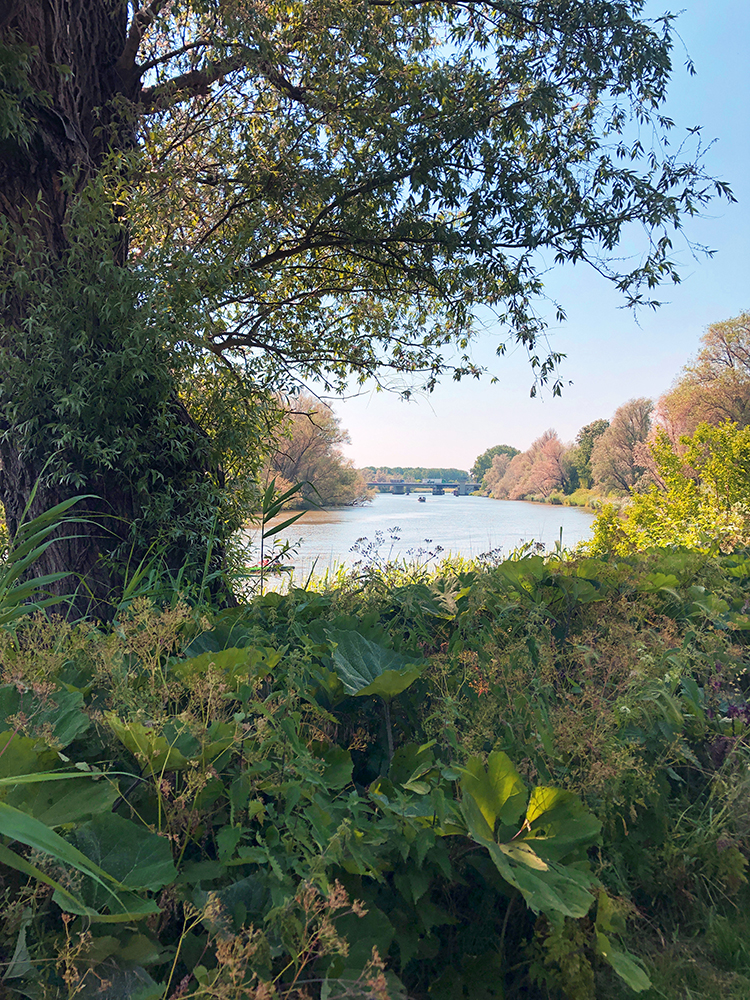
A view of the Wantij River in the Staart neighbourhood
If someone reading this wanted to engage their community in a biodiversity and greening initiative in their city, what advice would you give them?
If someone reading this is eager to engage their community in a biodiversity and greening initiative in their city, I would offer the following advice:
1. Ask and Listen: Start by engaging with the community and actively listening to their concerns, ideas, and aspirations. Understanding their perspectives is crucial to crafting initiatives that resonate with them.
2. Build Real Connections: Establish genuine and meaningful relationships with community members. Creating a sense of trust and camaraderie is the foundation of successful engagement.
3. Honesty is Key: Be transparent about what you can and cannot achieve. Avoid making unrealistic promises or overcommitting. Trust is built on honesty.
4. Be a Part of the Community: Instead of imposing plans and resources from the outside, aim to become an integral part of the community. Be present, involved, and invested in the well-being of the neighbourhood.
5. Collaborate from Within: Work to effect change from within the community. Engage residents as active participants in the initiative rather than passive beneficiaries. Shared ownership is vital for sustainability.
6. Invest Time: Dedicate the time required to understand the wishes and needs of the community thoroughly. Tailor initiatives to align with those needs, ensuring that they genuinely benefit the neighbourhood.
In essence, the key to a successful biodiversity and greening initiative is to be deeply connected to the community, respectful of its unique characteristics and needs, and committed to fostering positive change from within. By embracing these principles and building strong relationships, you can lay the groundwork for a flourishing and sustainable initiative that enhances both the environment and the community's quality of life.
